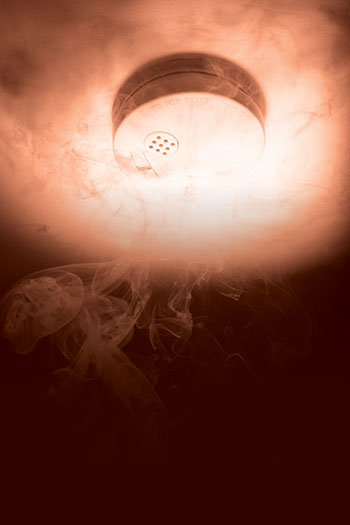Requirements for audibility of a fire alarm system (FAS) are governed by Article 3.2.4.19. of the National Building Code of Canada (NBCC). So, why is this subject being discussed in a purely electrical publication? The answer is quite obvious — because fire alarm systems are designed by electrical designers, components of fire alarm systems are shown on the electrical drawings and specifications, and installation of fire alarm systems is performed by electrical contractors under the scope of their electrical permits. But who inspects such installations? To answer this question is not that easy, as this depends on each jurisdiction, and on the scope of responsibilities of each inspections group in such jurisdiction.
Traditionally, electrical inspectors audit compliance of the wiring methods with provisions of Section 32 of the CE Code or even compliance of installation of FAS devices with requirements of ULC S524. Building inspectors usually review compliance of the fire alarm system with relevant provisions of the NBCC and, occasionally, with ULC S524. In some jurisdictions, fire prevention inspectors are assigned to audit installation of fire alarm systems, including a review of the FAS audibility. However, the subject of fire alarm audibility requirements is not consistently applied by the designers, electrical contractors, and regulators.
Let’s evaluate some provisions of Article 3.2.4.19. of the NBCC, which apparently create confusion among the designers, installers and regulators. For the purpose of such evaluation, we’ll concentrate on Sentences (1) to (7) of this NBCC Article.
Sentences 3.2.4.19.(1) – 3.2.4.19.(7) of the NBCC state the following:
“(1) Audible signal devices forming part of a fire alarm system shall be installed in a building so that
(a) alarm signals are clearly audible throughout the floor area, and
(b) alert signals are clearly audible in continuously staffed locations, and where there are no continuously staffed locations, throughout the floor area.
(2) The sound pattern of an alarm signal shall conform to the temporal pattern defined in Clause 4.2 of ISO 8201, “Acoustics – Audible emergency evacuation signal.”
(3) The sound pattern of alert signals shall be significantly different from the temporal patterns of alarm signals.
(4) The fire alarm signal sound pressure level shall not be more than 110 dBA in any normally occupied area.
(5) The sound pressure level in sleeping room from a fire alarm audible signal device shall be not less than 75 dBA in a building of residential or care occupancy when any intervening doors between the device and the sleeping room are closed.
(6) Except as required by Sentence (5), the sound pressure level from a fire alarm system’s audible signal device within a floor area shall be not less than 10 dBA above the ambient noise level without being less than 65 dBA.
(7) Except as permitted by Sentence (11), audible signal devices located within a dwelling unit shall include a means for them to be manually silenced for a period of not more than 10 min, after which time the devices shall restore themselves to normal operation.”
It should be noted that the requirements of Article 3.2.4.19. of the NBCC listed above are provided with clarification notes in Appendix A of the NBCC — to explain the intent of their application.
It should also be noted that such terms as “floor area,” “residential or care occupancy,” “dwelling unit,” “alarm signals,” and “alert signals” are defined in the NBCC, and that it is very important to understand and correctly use these definitions in conjunction with the provisions of Article 3.2.4.19. of the NBCC.
For example, “alarm signal” is defined by the NBCC as “an audible signal transmitted throughout a zone or zones or throughout a building to advise occupants that a fire emergency exists.” “Alert signal” represents a different meaning in accordance with the NBCC definition, and it is defined as “an audible signal to advise designated persons of a fire emergency.”
When these two definitions are applied in conjunction with Sentence 3.2.4.19.(1) above, it is transparently clear that an alert signal is not intended for the building occupants, but is intended only for designated (well-trained and well-qualified) persons who in accordance with the adopted fire safety plan in the building would be able to analyze the source of the alert signal and to actuate an alarm signal in specific zones (or throughout the entire building, if necessary). This is the reason that Sentence 3.2.4.19.(2) of the NBCC mandates that only an alarm signal must meet internationally accepted sound pattern. The NBCC recognizes that even in accordance with a perfectly executed fire safety plan, complete reliance on the designated persons should be limited. As such, the NBCC mandates that if the alert signal is not acknowledged within 5 minutes of its initiation, the alarm signal must sound automatically [see Sentence 3.2.4.4.(2) of the NBCC], and that upon actuation of the alert signal in the building, an immediate automatic notification of the fire department will take place [see Sentence 3.2.4.8.(3) of the NBCC]. It is interesting to note that despite the above stated objective of the NBCC for activation of the alert signal (for operation of the 1st stage of the FAS), and despite the fact that a building is provided with designated persons in continuously staffed location, many designers design a fire alarm system so, that alert signals are clearly audible throughout the entire building—thus confusing the building occupants. It is also interesting to note that such design takes place mainly because some AHJ has specifically mandated such design, disregarding provisions of the NBCC adopted in their jurisdictions and provisions of the adopted (and accepted by the fire departments) fire safety plan. Without discussing extreme situations of confusion that may arise in hospitals and detention facilities due to such design, it is easy to imagine a needless evacuation of occupants of a hotel in the middle of the night or spectators in the middle of performance in a typical theater or concert hall, when an alert signal is actuated in the building in which well-trained dedicated staff are present.
Perhaps, it is appropriate now to discuss the practicality of Sentence 3.2.4.19.(2) of the NBCC for the purpose of consistent enforcement of the sound pattern of an alarm signal. Consistency in auditing compliance of this sound pattern to Clause 4.2 of ISO 8201 is also highly questionable, as the electrical designers simply specify audible signal devices that are constructed in accordance with ULC standard S525 “AUDIBLE SIGNAL DEVICES FOR FIRE ALARM SYSTEMS, INCLUDING ACCESSORIES.” It should be noted that when audible signal devices are designed, constructed and certified to this ULC standard, they must generate a sound pattern conforming to Clause 4.2 of ISO 8201, otherwise such audible signal devices will not be considered to be “approved” in accordance with Rule 2-024 of the CE Code, Part I.
So, performance requirement of Sentence 3.2.4.19.(2) of the NBCC does not appear to be necessary, as the ULC standard that applies to construction and testing of the audible signal devices must already take care of such performance criteria. Sentence 3.2.4.19.(3) of the NBCC clarifies to the Code users that although the sound pattern of an alarm signal must follow a very specific international requirement, there are no such requirements for the sound of an alert signal (as alert signal is only intended for designated persons), and the alert signal must only sound “significantly” different from the alarm sound. And, of course, there are no consistent design and enforcement criteria for a sound of an alert signal through various jurisdictions in the country.
Sentences 3.2.4.19.(4), (5) and (7) of the NBCC are quite interesting, as they combine safety and performance criteria in respect to the sound pressure level generated by an audible signal device. Restriction of the sound pressure level to 110 dBA is based on the health safety of occupants exposed to a very high dBA level of sound. This means that under no condition is a sound pressure level of audible signal devices installed in a public corridor of a residential building allowed to exceed 110 dBA. This also means—although is not specifically mandated by the NBCC— that in order to meet the performance criteria of Sentence 3.2.4.19.(5), at least one audible signal device would have to be located inside a dwelling unit. The statement by the author above is based on the audibility sound pressure levels data published in ULC S524. Appendix C of ULC S524 provides examples of a typical sound pressure level output for various types of audible signal devices and for various distances from these devices. It also provides an average value of sound pressure level loss when doors or walls block sound. In light of this information from ULC S524 (which indicates an average sound pressure level loss of 25 dBA when a door to a sleeping room is closed), it is inevitable that at least one audible signal device would have to be designed by an electrical designer for installation in a dwelling unit; otherwise, the performance requirement of 75 dBA in a sleeping room with the door being closed is simply not practicable to achieve. Thus, the NBCC recognizes that an audible signal device would have to be located inside a dwelling unit, and Sentence 3.2.4.19.(7) of the NBCC mandates installation of manual silencing means for the audible signal device which is located inside a dwelling unit. This NBCC requirement is intended to prevent any potential tampering (i.e., Illegal or improper alteration of, or interference with) the audible signal device by the dwelling unit occupants.
It is interesting to note that Sentence 3.2.4.19.(6) of the NBCC mandates that in floor areas of occupancies other than residential occupancies, “the sound pressure level from a fire alarm system’s audible signal device within a floor area shall be not less than 10 dBA above the ambient noise level without being less than 65 dBA.” This NBCC requirement does not specifically mandate that the minimum sound pressure level of 65 dBA must be achieved in various rooms constructed within a typical floor area (i.e., doors of boardrooms, office rooms, storage rooms, etc.) with intervening doors to such rooms being closed. This requirement of the NBCC has created lots of confusion and inconsistency, as some audibility tests are conducted with doors to these boardrooms being open while some tests are done with the doors to these rooms being closed. Although the NRC technical staff have provided informal interpretation on this issue by indicating that audibility tests could be conducted with doors to such boardrooms being open or closed, there is no formal clarification on this matter in Appendix A Note on Sentence 3.2.4.19.(6) of the NBCC. Thus, absence of clarity in the Code on this subject creates a tangible financial burden on the building owners when design is not based on the minimum fire alarm system audibility level of 65 dBA in a typical boardroom, with the boardroom door being closed, as some inspection authorities require to add an audible signal device in each such boardroom or office room, in order to achieve at least 65 dBA of the sound pressure level in the room with the door being closed.
Such requirement by an AHJ may create unintended implications, as an audible signal device installed in a boardroom or an office room constructed within a floor area quite often generates a sound pressure level in excess of 90 dBA, and such sound pressure level exceeds work health and safety provisions of many local occupational health and safety regulations.
For example, Part 7 of the BC Occupation Health and Safety Regulation states the following:
“7.2 Noise exposure limits
An employer must ensure that a worker is not exposed to noise levels above either of the following exposure limits:
(a) 85 dBA Lex daily noise exposure level;
(b) 140 dBC peak sound level.
[Enacted by B.C. Reg. 382/2004, effective January 1, 2005.]
7.3 Noise measurement required
(1) If a worker is or may be exposed to potentially harmful levels of noise, or if information indicates that a worker may be exposed to a level exceeding 82 dBA Lex, the employer must measure the noise exposure.”
This subject represents a simple illustration of the area outside of the purely electrical safety issues mandated by the CE Code, but where electrical consultants, electrical contractors, and fire alarm system verification specialists involved in design, installation and verification of fire alarm systems have to discuss all relevant issues with the appropriate AHJs enforcing requirements of the NBCC for electrically connected life safety systems (i.e., with the AHJs, who are not necessarily electrical inspections authorities).
This particular example illustrates imperfection of the NBCC provisions regarding audible signal devices of fire alarm systems, and it demonstrates a need for continuing correlation among all applicable stakeholders involved in the implementation of electrical and fire safety objectives of the NBCC.












Find Us on Socials